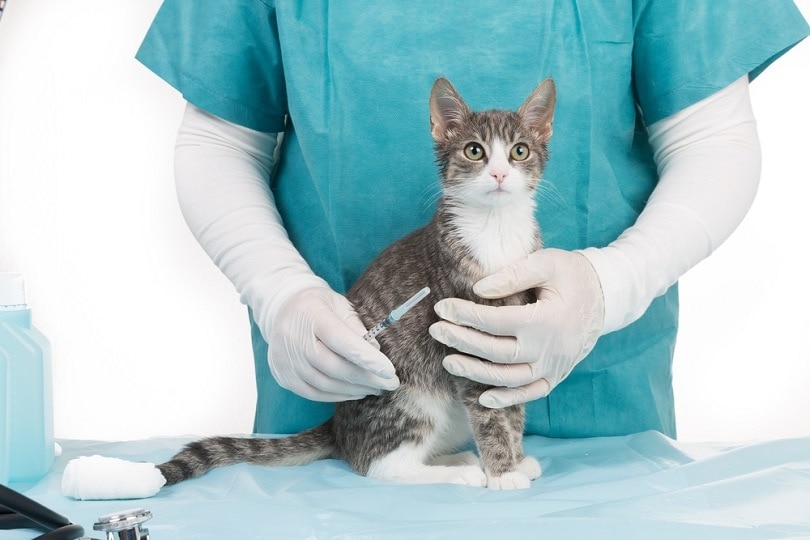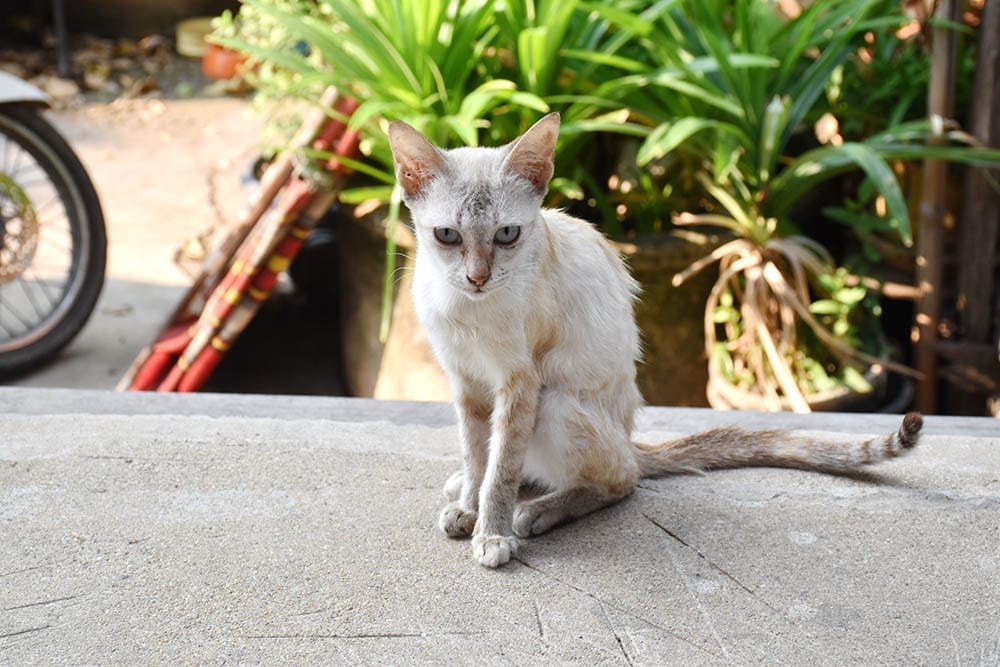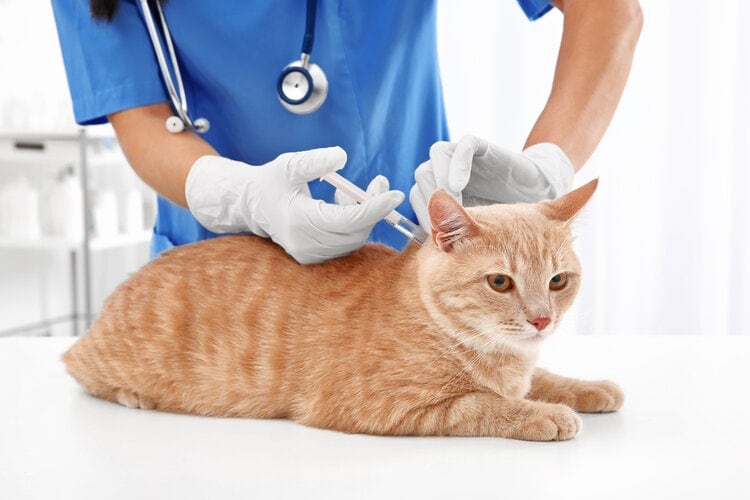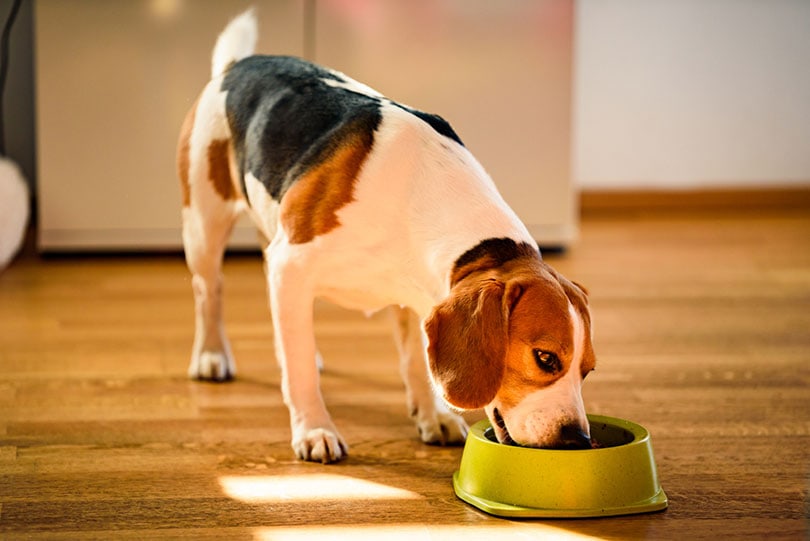FeLV Vaccine For Cats: A Complete Guide (Vet Answer)
By Dr. Leigh Wilder, DVM (Vet)
Updated on

Click to Skip Ahead
Vaccines are an important aspect of preventative care for your feline companion. Together with your veterinarian, determining the specific vaccines your cat or kitten needs is an important step in creating a plan to keep them as healthy as possible. Vaccines are available to protect against a variety of diseases in cats, including Feline Leukemia Virus, an illness of importance worldwide. The following article will provide background information on Feline Leukemia Virus and discuss its corresponding vaccine in-depth to make navigating your cat’s preventative care needs as straightforward as possible.
What Is Feline Leukemia Virus?
Feline Leukemia Virus (FeLV) is a common infectious disease of cats, affecting approximately 3% of cats in the United States. The FeLV retrovirus is transmitted via close contact with other cats, and is most commonly spread in the saliva of infected cats; however, nasal secretions, urine, feces, and milk may also play a role in transmission. Additionally, FeLV may also be transferred between a mother cat and her kittens before they are born. FeLV does not persist long in the environment, and most often requires prolonged close contact to cause new infections.
- Weight loss
- Inappetence
- Lethargy
- Ocular abnormalities
- Fever
- Enlarged lymph nodes
- Seizures or other neurologic abnormalities
- Diarrhea
Clinical signs noted in FeLV-positive cats may be secondary to immunosuppression caused by the virus, or directly related to the viral infection itself. Conditions seen commonly in felines infected with FeLV include neoplasia such as lymphoma or leukemia, gingivostomatitis, anemia, and infectious disease (bacterial, fungal, protozoal, or viral infections). Kittens have a higher risk of becoming infected with FeLV than adult cats, however, cats of any age may become infected.

FeLV Diagnosis, Prognosis, and Treatment
FeLV can be diagnosed with an enzyme-linked immunosorbent assay (ELISA) blood test at your veterinary clinic. While most tests are fairly accurate, after a positive test confirmatory or follow-up testing through a reference laboratory may be recommended. After diagnosis, FeLV-positive felines have an average survival time of 2.4 years. The clinical course of disease tends to progress more rapidly in kittens; however, some adult cats may live many years with a good quality of life.
There is, unfortunately, no cure for FeLV infection. Treatments consisting of antiretroviral drugs and interferons have been attempted, however, studies on their efficacy are limited. Regular veterinary check-ups and preventative care are essential for FeLV-positive cats, as they allow for early identification and treatment of FeLV-associated diseases noted above.
How Does the FeLV Vaccine Work?
The two types of vaccines currently available to protect against FeLV are inactivated and recombinant vaccines. Inactivated vaccines contain a “killed” antigen, as well as adjuvants or other proteins designed to elicit an immune response. Full protection from this type of vaccine is often not obtained until 2–3 weeks after the last dose. Recombinant vaccines are created through DNA manipulation of a pathogen, which renders the pathogen less virulent. In North America, recombinant vaccines for felines use a recombinant canarypox virus as a vector. This type of vaccine results in more rapid immunity as compared to inactivated vaccines.
The ultimate goal of vaccination is to “train” the immune system to recognize and respond to a specific infectious agent by producing antibodies or activating cells that will kill the invading pathogen. When a vaccinated cat encounters the pathogen again in the future, its body rapidly produces antibodies and activates cells that recognize and eliminate the specific disease agent. While vaccines are an essential component of preventative care, it is important to remember that no vaccine is 100% effective.

Which Cats Should Receive the FeLV Vaccine?
The FeLV vaccine is considered a core vaccine for kittens less than 1 year of age by the American Animal Hospital Association (AAHA) and the American Association of Feline Practitioners (AAFP), due to kittens’ age-related susceptibility to the virus. Core vaccines are recommended for all kittens and cats with an unknown vaccination history.
The FeLV vaccine is considered a non-core vaccine for adult cats. Non-core vaccines should be administered to a specific pet based on their lifestyle and risk of exposure to a certain disease. A discussion with your veterinarian will best help to determine whether your adult cat should receive the FeLV vaccine, however, the following general guidelines can be considered:
- Cats at high risk for FeLV should be vaccinated—this includes cats with regular exposure to FeLV-positive cats (or cats with unknown FeLV status) either indoors or outdoors.
- Cats at low risk for FeLV may not require vaccination— this includes indoor-only cats and those who live with a small number of other cats that are negative for FeLV.
All cats should be tested for FeLV before vaccination, as there is no benefit in administering an FeLV vaccine to an already-infected feline.
FeLV Vaccine Schedule and Cost
Your veterinarian will help to determine an appropriate vaccine schedule to keep your cat protected from FeLV based on current vaccination guidelines.
- Initially, two doses of the FeLV vaccine are administered 3–4 weeks apart in cats greater than 8 weeks of age.
- Cats are then re-vaccinated 12 months after the last dose in the series, and then either annually or every 2–3 years depending on a cat’s specific level of risk and the vaccine product used.
Costs associated with the FeLV vaccine vary widely depending on your geographical area and the specific services provided by your veterinary clinic. To obtain the most accurate estimate of cost to vaccinate your cat against FeLV, it is recommended to contact your veterinarian prior to your appointment.
Risks Associated With the FeLV Vaccine
Feline vaccines in general carry an excellent safety record, and the risk of adverse reactions in cats is considered to be low. However, it is important to note that there is some inherent risk involved in any medical intervention, including vaccination. The most commonly noted vaccine reactions in felines include lethargy, anorexia, pain or swelling at the injection site, or mild fever for a few days after vaccination. These reactions may be mild and resolve on their own, or may require medical intervention.
Anaphylactic reactions, while rare, may also occur following vaccination in cats. Signs of anaphylaxis in cats may include vomiting, diarrhea, itching, facial swelling, respiratory distress, or acute collapse. If any of these signs are noted following vaccination immediate evaluation by a veterinarian is warranted.
Lastly, veterinary attention is also recommended for any persistent lump or swelling noted post-vaccination in cats as it may be concerning for a feline injection-site sarcoma (FISS). FISSs are a type of cancerous growth that may occur at the injection site weeks to years after vaccination in cats. While serious, FISSs are uncommon and are seen at an approximate rate of 1 case per 10,000–30,000 vaccinations.
Vaccines are an important part of a comprehensive, preventative healthcare plan for your cat. However, the decision on whether to vaccinate for a specific disease should always be discussed with your veterinarian, and tailored to your cat’s individualized risk factors and lifestyle. By partnering with your veterinarian you will be able to best determine whether the benefits of vaccination for FeLV outweigh the potential risks, and make the best decision for the long-term health of your pet.
Featured Image Credit: bmf-foto.de, Shutterstock













